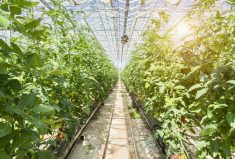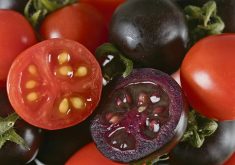The Vineland Research and Innovation Centre is working on solutions to a devastating disease in tomatoes, the brown rugose fruit virus.
It has undertaken a breeding program in collaboration with the Ontario agriculture department and Ontario Greenhouse Vegetable Growers.
Why it matters: There are no varieties resistant to tomato brown rugose fruit virus and infection makes the crop unmarketable.
Read Also

Ontario’s agri-food sector sets sights on future with Agri-Food 2050 initiative
The first-ever Agri Food 2050, a one-day industry event dedicated to envisioning the future of food and farming in Ontario,…
“Our rugose project plans to identify a source of resistance to the virus and then develop a genetic marker — laboratory-tested — that will allow us to quickly breed rugose resistance into our tomato lines,” said Travis Banks, Vineland’s director of plant variety development.
The virus causes discolouration of the tomato leaves, lowers production and causes fruit deformity.
“The virus itself does not cause a risk to human health. It makes the plants not as productive and the fruit not as [marketable],” says Banks.
Some reports indicate the virus can last for years within the greenhouse and the only current method of control is through biosecurity and sanitation.
“[It’s important to make] sure that the seeds growers plant in their greenhouse is from a reputable seed producer that has been verified to be free of the virus,” he says. OMAFRA has developed guidelines for growers to minimize the risk of the recurrence.
The Vineland research facility first received the funding in 2019. Since then it has collaborated with Agriculture and Agri-Food Canada (AAFC) stringing material together from domestic wild tomatoes to find material showing resistance.
“In addition to that, we partnered with Eminent Seeds to be involved with the collaboration taking place in Asia and Europe to screen more wild tomato germplasm collections as well, for resistance.”
Banks says results look promising and those trials have identified some material that appears to be resistant, and they have begun making crosses with that.
“Probably another year and a half for us to add rugose to our commercial lines that we already have available.”
Once rugose is added to the commercial lines the plants will still need to be evaluated by vegetable growers to ensure they continue to maintain their characteristics, along with being resistant to rugose.
The project continues the mission of Vineland’s breeding program targeted toward tomatoes-on-the-vine specific to the Canadian market.
“The mission of our tomato breeding program [is to] develop tomato varieties that are bred specifically for the Canadian climate that is going to result in a better profitability for growers,” says Banks. “We can also focus on diseases that are a particular concern to our growers.
“Industry and government have been clear that addressing this new disease is a top priority. Vineland is working as quickly as possible and Ontario-adapted TOVs from our breeding program with rugose resistance are on the horizon,” says Banks.















